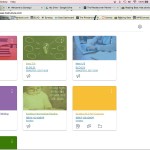“How has remote teaching changed you as a teacher?” my principal asked. Like a good educator, this question came at the end of our discussion. He had already walked me through guiding questions that he knew would churn up a thoughtful answer. So, after a careful pause, my response was sweeping and general: “I saw a lot of my blind spots illuminated while teaching remotely.”
Coincidentally, last February, on this blog, I wrote about the need to make computer education a part of all classroom instruction. Of course, and unfortunately, there was immediate vindication for my claims. And of course, reluctantly or intentionally, most students (and teachers) have had to develop better (or simply basic) computer skills.
I am among those who have drastically improved my technology skills — especially as it relates to academia. But this, in it of itself, is not what I was referencing when I told my principal that my blind spots had been illuminated.
The use of digital platforms over the course of remote learning forced me to find new ways to check for understanding. I could no longer relay on facial expressions and overhearing table-top conversations. The students, whether reluctant or unable, were less available to me via microphones or cameras. I had to be more specific with how I knew my students were understanding my lessons.
From using EdPuzzle to GoogleForms to PearDeck, I have developed traceable checks-for-understanding that are actually far more effective than anything I did in person. I used to allow processing and answering time for each student — they would talk with a partner or a group. I would have share outs to verify successes around the room. I figured, in the absence of having each student talk to me, this was an effective way. After all, if they didn’t “get it,” someone in their group would tell them, and if that didn’t work when I called on the exemplars for whole-class sharing, they’d pick it up there…. Right?
Well, in remote school trying to emulate all of the same steps, I found through Pear Deck, that still a small minority of students would be baffled, confused, or falling flat when I was giving notes or a lesson virtually. This allowed me to correct every misunderstanding live. It also allowed me to keep track of which students were struggling — and how often. Does this student have difficulties with each topic, or just this topic? Is it a few students, half the students, or most the students that need me to go back over that?
With EdPuzzle I could prerecord directions for assignments, with verification that the directions were understood built into it. An objective question of “Where do you turn the file in” or “How many paragraphs are expected” is way easier to verify than my old in-person standard: “Does everyone understand? … Any Questions?” You can follow up with students who missed the questions BEFORE they make mistakes on the actual assignment.
Google Forms was something I had used before, but using them deliberately to allow students who understand to finish quickly, while giving students who missed questions more practice proved very powerful in differentiated instructions.
I list those as specific tools I am privileged to be able to use in a school that ensured every student had a Chromebook at their house. They were essential in improving my student’s experience via my ability to react to their feedback. But, as I was explaining to my principal, even if the technology disappeared, even if I transfer to a district with less technology available, I cannot un-learn what I did this last year: My old check for understanding was flawed. I can teach without technology, but I won’t go back to “trusting” the students “get it.” If I find myself without these tools, I will develop my own and will not lull myself into believing a few head nods can replace checking in with each student directly.
For sure, I am changed as a teacher. For sure, I have been changed for the better. I did not love the world flipping upside down almost a year ago, but I certainly have grown from the experience, and all my future students will benefit as well.
How have you changed since the beginning of the pandemic? How did remote, hybrid, or perhaps other realities of teaching in person changed your approach to teaching? Leave a comment below!









